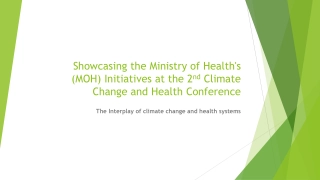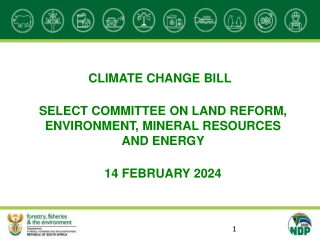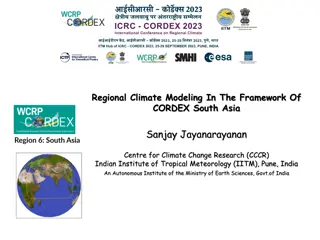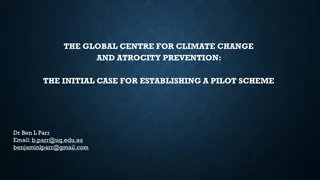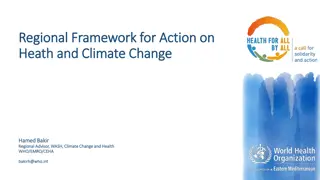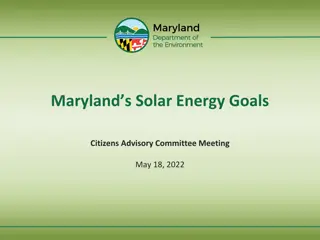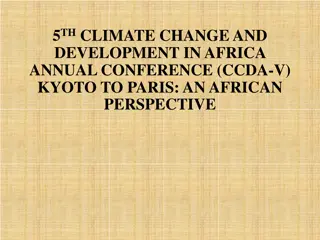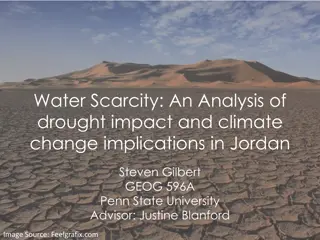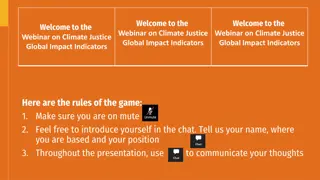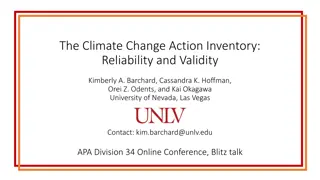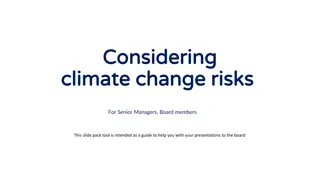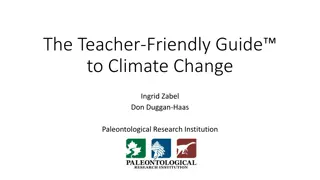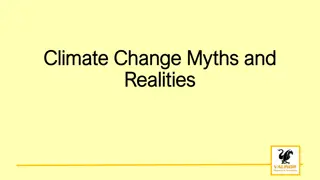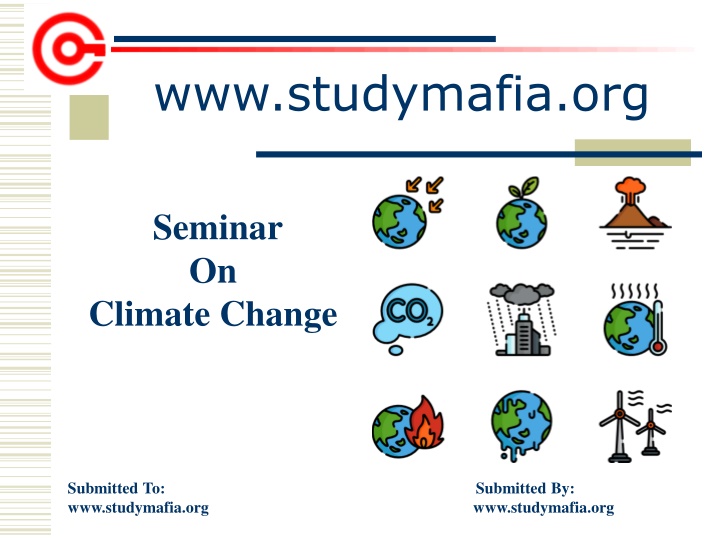
Climate Change and Its Causes
Explore the definitions and causes of climate change, including human and natural factors such as greenhouse gases, deforestation, and volcanic eruptions. Discover the effects of climate change and the ongoing debate on human responsibility.
Download Presentation

Please find below an Image/Link to download the presentation.
The content on the website is provided AS IS for your information and personal use only. It may not be sold, licensed, or shared on other websites without obtaining consent from the author. If you encounter any issues during the download, it is possible that the publisher has removed the file from their server.
You are allowed to download the files provided on this website for personal or commercial use, subject to the condition that they are used lawfully. All files are the property of their respective owners.
The content on the website is provided AS IS for your information and personal use only. It may not be sold, licensed, or shared on other websites without obtaining consent from the author.
E N D
Presentation Transcript
www.studymafia.org Seminar On Climate Change Submitted To: www.studymafia.org www.studymafia.org Submitted By:
CONTENT Introduction Definition of Climate Change Causes of Climate Change- Natural Causes & Human Causes Effects of Climate Change Are humans responsible for climate change? Conclusion References
Introduction Climate change is the change in our weather patterns that are occurring because of an increase in the earth's average temperature. It is also known as global warming. Climate change may result from both natural and human causes though the human causes appear to be increasingly responsible for climate change over the past few decades
Definition of Climate Change It is a change which is attributed directly or indirectly to human activity that alters the composition of the global atmosphere and which is in addition to natural climate variability observed over comparative time periods
Causes of Climate Change Human causes of climate change Greenhouse gases Deforestation Coal mining Industrial processes Agriculture Natural changes to the climate Volcanic eruptions Solar irradiance El Ni o Southern Oscillation (ENSO) Milankovitch cycles
Natural changes to the climate Volcanic eruptions Solar irradiance El Ni o Southern Oscillation (ENSO) Milankovitch cycles
Volcanic eruptions Volcanoes have a mixed effect on our climate. Eruptions produce aerosol particles that cool Earth, but they also release carbon dioxide, which warms it. Volcanoes produce 50 times less carbon dioxide than humans do, so we know they are not the leading cause of global warming. On top of this, cooling is the dominant effect of volcanic eruptions, not warming.
Solar irradiance Changing energy from the sun has affected the temperature of Earth in the past. However, we have not seen anything strong enough to change our climate. Any increase in solar energy would make the entire atmosphere of Earth warm, but we can only see warming in the bottom layer.
El Nio Southern Oscillation (ENSO) ENSO is a pattern of changing water temperatures in the Pacific Ocean. In an 'El Ni o' year, the global temperature warms up, and in a 'La Ni a' year, it cools down. These patterns can affect the global temperature for a short amount of time (months or years) but cannot explain the persistent warming that we see today.
Milankovitch cycles As Earth travels around the sun, its path and the tilt of its axis can change slightly. These changes, called Milankovitch cycles, affect the amount of sunlight that falls on Earth. This can cause the temperature of Earth to change. However, these cycles take place over tens or hundreds of thousands of years and are unlikely to be causing the changes to the climate that we are seeing today.
HUMAN CAUSES (Anthropogenic or Man-made causes) Greenhouse gases Deforestation Coal mining Industrial processes Agriculture
Greenhouse Effect The greenhouse effect is a natural process that warms the Earth s surface. When the Sun s energy reaches the Earth s atmosphere, some of it is reflected back to space and the rest is absorbed and re-radiated by greenhouse gases.
Deforestation Forests remove and store carbon dioxide from the atmosphere. Cutting them down means that carbon dioxide builds up quicker since there are no trees to absorb it. Not only that, trees release the carbon they stored when we burn them.
Coal Mining Coal mining, extraction of coal deposits from the surface of Earth and from underground. Coal is the most abundant fossil fuel on Earth. Its predominant use has always been for producing heat energy.
Industrial processes Industrial processes are procedures involving chemical, physical, electrical or mechanical steps to aid in the manufacturing of an item or items, usually carried out on a very large scale. Industrial processes are the key components of heavy industry
Agriculture Agricultural waste is waste produced as a result of various agricultural operations. It includes manure and other wastes from farms, poultry houses and slaughterhouses; harvest waste; fertilizer run- off from fields; pesticides that enter into water, air or soils; and salt and silt drained from fields.
Effects of Climate Change According to the World Economic Forum s Global Risks Report 2021, the failure to mitigate and adapt to climate change is the most impactful risk facing communities worldwide ahead of even weapons of mass destruction and water crises. Blame its cascading effects: As climate change transforms global ecosystems, it affects everything from the places we live to the water we drink to the air we breathe.
Extreme weather As the earth s atmosphere heats up, it collects, retains, and drops more water, changing weather patterns and making wet areas wetter and dry areas drier. Higher temperatures worsen and increase the frequency of many types of disasters, including storms, floods, heat waves, and droughts.
Dirty air Air pollution and climate change are inextricably linked, with one exacerbating the other. When the earth s temperatures rise, not only does our air get dirtier with smog and soot levels rising accordingly but it also becomes filled with more allergenic pollutants, such as circulating mold (thanks to damp conditions from extreme weather and more floods) and pollen (due to longer, stronger pollen seasons).
Health risks According to the World Health Organization, climate change is expected to cause approximately 250,000 additional deaths per year between 2030 and 2050. As global temperatures rise, so do the number of fatalities and illnesses from heat stress, heatstroke, and cardiovascular and kidney disease. And as air pollution worsens, so does respiratory health particularly for the 300 million people living with asthma worldwide; there s more airborne pollen and mold to torment hay fever and allergy sufferers too.
Rising seas The Arctic is heating up twice as fast as any other place on the planet. As its ice sheets melt into the seas, our oceans are on track to rise by anywhere from 0.95 to 3.61 feet by the end of this century, threatening coastal ecosystems and low-lying areas. Island nations face particular risk, as do some of the world s largest cities, including New York City, Miami, Mumbai in India, and Sydney in Australia.
Imperiled ecosystems Climate change is increasing pressure on wildlife to adapt to changing habitats and fast. Many species are seeking out cooler climates and higher altitudes, altering seasonal behaviors, and adjusting traditional migration patterns. These shifts can fundamentally transform entire ecosystems and the intricate webs of life that depend on them. As a result, according to a 2020 study, one-third of all animal and plant species could face extinction by 2070.
Are humans responsible for climate change? When looking at all the evidence, there is a large scientific consensus that humans are the leading cause of climate change. In their latest report, the Intergovernmental Panel on Climate Change stated unequivocally that human activity is the cause of global warming. Natural climate cycles can change the temperature of Earth, but the changes we are seeing are happening at a scale and speed that natural cycles cannot explain. These cycles affect the global temperature for years, or sometimes just months, not the 100 years that we have observed. Meanwhile, longer- term changes like Milankovitch cycles and solar irradiance take thousands and thousands of years.
Conclusions Based on the results we got about our carbon footprints, we discussed different ways to reduce it without losing quality of life. We found out it s quite hard, as new technologies aren t always available in the market and are usually really expensive. In our country we can see many direct consequences of climate change: we ve recently suffered from floods, droughts, we have hotter summers and colder winters (we even had snowfall in our city, which is really unusual!).
References www.google.com www.wikipedia.com www.studymafia.org

